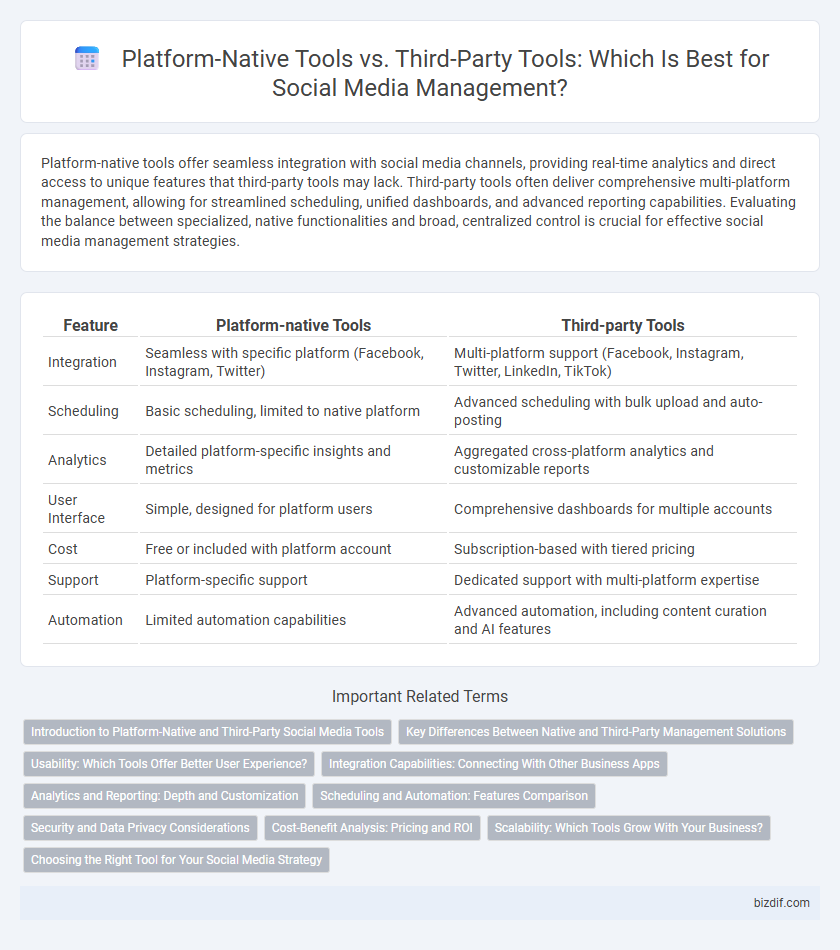Platform-native tools offer seamless integration with social media channels, providing real-time analytics and direct access to unique features that third-party tools may lack. Third-party tools often deliver comprehensive multi-platform management, allowing for streamlined scheduling, unified dashboards, and advanced reporting capabilities. Evaluating the balance between specialized, native functionalities and broad, centralized control is crucial for effective social media management strategies.
Table of Comparison
| Feature | Platform-native Tools | Third-party Tools |
|---|---|---|
| Integration | Seamless with specific platform (Facebook, Instagram, Twitter) | Multi-platform support (Facebook, Instagram, Twitter, LinkedIn, TikTok) |
| Scheduling | Basic scheduling, limited to native platform | Advanced scheduling with bulk upload and auto-posting |
| Analytics | Detailed platform-specific insights and metrics | Aggregated cross-platform analytics and customizable reports |
| User Interface | Simple, designed for platform users | Comprehensive dashboards for multiple accounts |
| Cost | Free or included with platform account | Subscription-based with tiered pricing |
| Support | Platform-specific support | Dedicated support with multi-platform expertise |
| Automation | Limited automation capabilities | Advanced automation, including content curation and AI features |
Introduction to Platform-Native and Third-Party Social Media Tools
Platform-native social media tools are built into platforms like Facebook, Instagram, and Twitter, offering seamless integration with native features such as analytics, content scheduling, and direct engagement. Third-party social media tools like Hootsuite, Buffer, and Sprout Social provide multi-platform management, enhanced reporting, and automation capabilities not always available on native tools. Choosing between platform-native and third-party tools depends on the scale of social media management, required features, and the need for centralized control across multiple accounts.
Key Differences Between Native and Third-Party Management Solutions
Platform-native tools offer seamless integration, real-time analytics, and direct access to platform-specific features like Stories and Reels, ensuring optimized content performance and compliance with platform policies. Third-party tools provide broader multi-platform management with advanced scheduling, cross-posting, and consolidated reporting, enabling streamlined workflows across various social networks. Key differences include depth of feature access, data accuracy due to API limitations, and the trade-off between specialized platform functionality versus centralized control.
Usability: Which Tools Offer Better User Experience?
Platform-native tools in social media management often provide a more seamless user experience due to their direct integration with the platform's features and updates, ensuring real-time functionality and compatibility. Third-party tools, while offering advanced analytics and multi-platform management capabilities, may experience latency or limited feature access, affecting usability. User experience is typically superior in native tools for day-to-day posting and engagement, whereas third-party tools excel in comprehensive data analysis and workflow customization.
Integration Capabilities: Connecting With Other Business Apps
Platform-native tools offer seamless integration with their own ecosystem, ensuring real-time synchronization and optimized performance across native apps like Instagram, Facebook, and Twitter. Third-party tools excel in connecting diverse business applications, such as CRM software, email marketing platforms, and analytics tools, providing centralized management and data aggregation. Strong integration capabilities in third-party tools enhance workflow automation, improve data accuracy, and enable comprehensive reporting for social media campaigns.
Analytics and Reporting: Depth and Customization
Platform-native tools provide real-time, in-depth analytics tailored specifically to their environment, offering precise data on user engagement and content performance. Third-party tools deliver enhanced customization options, aggregating data across multiple social media channels for comprehensive, cross-platform reports. Marketers benefit from combining the detailed insights of native analytics with the versatile reporting capabilities of third-party solutions to optimize social media strategies effectively.
Scheduling and Automation: Features Comparison
Platform-native tools offer seamless integration with social media networks, providing real-time scheduling and automation features tailored to each platform's unique algorithms and restrictions. Third-party tools enhance efficiency by supporting multiple social channels from a single dashboard, often including advanced automation options like bulk scheduling, AI-driven content recommendations, and performance analytics. Choosing between native and third-party solutions depends on the need for specialized platform features versus comprehensive, multi-channel management capabilities.
Security and Data Privacy Considerations
Platform-native social media management tools offer enhanced security by leveraging built-in authentication protocols and direct data control, reducing the risk of breaches compared to third-party tools. Third-party tools often require extensive permissions and API access, which can expose sensitive user data to external vulnerabilities and compliance challenges. Organizations must evaluate the security certifications and data privacy policies of third-party providers to ensure alignment with regulatory standards such as GDPR or CCPA.
Cost-Benefit Analysis: Pricing and ROI
Platform-native tools often provide cost-effective solutions with built-in features designed specifically for their social media environment, minimizing learning curves and integration issues. Third-party tools typically offer broader functionality and cross-platform management but require subscription fees that may exceed smaller budgets, impacting overall ROI. Businesses must assess usage frequency, feature requirements, and scalability to determine which option delivers better long-term value and return on investment.
Scalability: Which Tools Grow With Your Business?
Platform-native tools offer seamless integration and real-time updates tailored specifically to each social media channel, ensuring consistent performance for small to medium-sized businesses. Third-party tools provide advanced analytics, multi-platform management, and automation features that scale effectively with growing marketing teams and increasing content demands. Choosing tools with robust API access and customizable workflows ensures adaptability and supports long-term expansion in social media strategies.
Choosing the Right Tool for Your Social Media Strategy
Platform-native tools offer seamless integration and real-time analytics tailored to each social media network, ensuring precise audience targeting and native feature utilization. Third-party tools provide comprehensive management capabilities across multiple platforms, including scheduling, cross-posting, and unified reporting, which enhances workflow efficiency for businesses managing diverse social channels. Selecting the right tool depends on balancing specific platform functionality needs with the convenience of centralized management to optimize social media strategy performance.
Platform-native tools vs third-party tools Infographic

 bizdif.com
bizdif.com